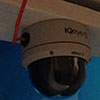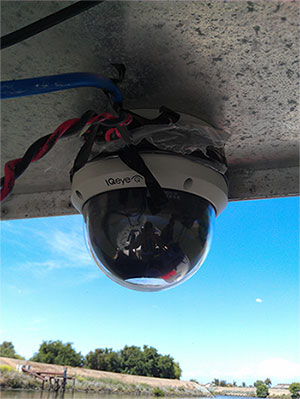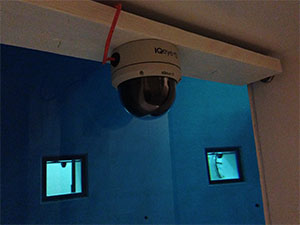
NOAA Deploys IQinVision Cameras to Upgrade Research Work
IQinVision, a manufacturer of high-performance HD megapixel IP cameras, announced that the National Oceanic and Atmospheric Administration’s (NOAA) Southwest Fisheries Science Center (SWSFC), in La Jolla, CA, has installed IQinVision megapixel cameras to provide surveillance of the experiments conducted in their new Ocean Technology Development Tank.
 The new SWFSC laboratory houses the large-scale, controlled-environment Ocean Technology Development Tank. This world-class facility will expand NOAA's ability to develop and apply advanced technologies for ecosystem-based surveys of fish and protected species and will foster collaborations on ocean sampling technologies with local, regional and international partners.
The new SWFSC laboratory houses the large-scale, controlled-environment Ocean Technology Development Tank. This world-class facility will expand NOAA's ability to develop and apply advanced technologies for ecosystem-based surveys of fish and protected species and will foster collaborations on ocean sampling technologies with local, regional and international partners.
Although several facilities in the US and abroad have some form of a test tank, no tank currently exists that has all the characteristics required to realize the advanced technologies essential for achieving NOAA's current and future missions. The SWFSC Ocean Technology Development Tank will be the only large (10 m wide x 20 m long x 10 m deep), thermohaline-controlled test tank facility in the world, which is also able to accommodate live animals.
NOAA and Dr. Kevin Stierhoff, Research Fisheries Biologist at NOAA Fisheries’ SWFSC, were introduced to IQinVision megapixel technology by Dr. David Demer, Leader of the Advanced Survey Technologies Group at the SWFSC, who had used IQinVision cameras in the past.
“We knew we needed high-quality images of everything going in the tank during experimentation, but we didn’t have the budget for all the cameras we needed,” explained Stierhoff. “IQinVision matched the number of cameras that we purchased with donated cameras. We simply wouldn’t have been able to achieve our goals without their donation.”
Stierhoff and the rest of the researchers have to be able to observe the equipment in the tank so they can understand what modifications are needed to achieve the equipment functionality they want.
“We can now deploy cameras on custom brackets into any of the nine 3’ x 3’ viewing windows located around the periphery of the tank to view the various pieces of equipment that we put into the tank for our experiments. We don’t need to cover all nine windows; we can strategically place the cameras to get the views and coverage we need from above and at different levels within the tank.”
Now, the NOAA staff can do real-time observations and go back afterwards to study archival footage to validate and verify their instrument data with what was happening in the tank at the same time.
 The tank can support life and Stierhoff and colleagues plan to put fish and plankton in the tank to observe them with echosounders, while the cameras allow the researchers to directly observe the animal behavior in real-time as well as afterward. Video surveillance footage runs on a separate, internal network and can be viewed anywhere in the building. NOAA is using eight IQeye Alliance-pro, 3 MP cameras attached to a power-over-Ethernet (PoE) switch for their work. Staff view and record 720p digital video at 15 frames per second.
The tank can support life and Stierhoff and colleagues plan to put fish and plankton in the tank to observe them with echosounders, while the cameras allow the researchers to directly observe the animal behavior in real-time as well as afterward. Video surveillance footage runs on a separate, internal network and can be viewed anywhere in the building. NOAA is using eight IQeye Alliance-pro, 3 MP cameras attached to a power-over-Ethernet (PoE) switch for their work. Staff view and record 720p digital video at 15 frames per second.
Another important aspect of the tank’s use is NOAA’s goal to make this unique technology available in a collaborative manner with other groups who wish to conduct experiments and share findings. Stierhoff is pleased that NOAA can offer these outside partner groups high-quality surveillance capabilities and that they can easily extract video footage from the cameras’ on-board storage and transfer it to such partners when requested. The NOAA system uses an ExacqVision VMS client to manage the IQeye camera footage.
“We’ve looked at a good bit of footage in the few weeks since their installation and my colleagues at NOAA are quite happy with the light sensitivity and image quality. It’s critical that we can clearly see what is going on in the tank,” said Stierhoff.
As scientists are inclined to do, Stierhoff and colleagues are already experimenting with other uses for the IQeye cameras, aside from documenting experiments in the tank. “A colleague is counting fish and mapping the stream bed in several rivers near Sacramento, CA. He’s using IQeye megapixel cameras to synchronously record footage of the stream bank and correlating that video with echosounder data to see whether the type of habitat present along the river affects fish aggregation. As always, we’re trying to better understand what is going on in our ecosystem, and we’re developing new ways to collect better data to answer those questions.”
“There are many camera solutions on the market that could have satisfied the minimal camera requirements for the applications that we had in mind. But the IQeye megapixel cameras with Edge technology provided the most bang-for-the-buck and integrated nicely with the Technology Tank to get us collecting video quickly and easily as possible. And the quality video will provide invaluable insight into experiments that we’ll conduct now and in the future,” said Stierhoff.